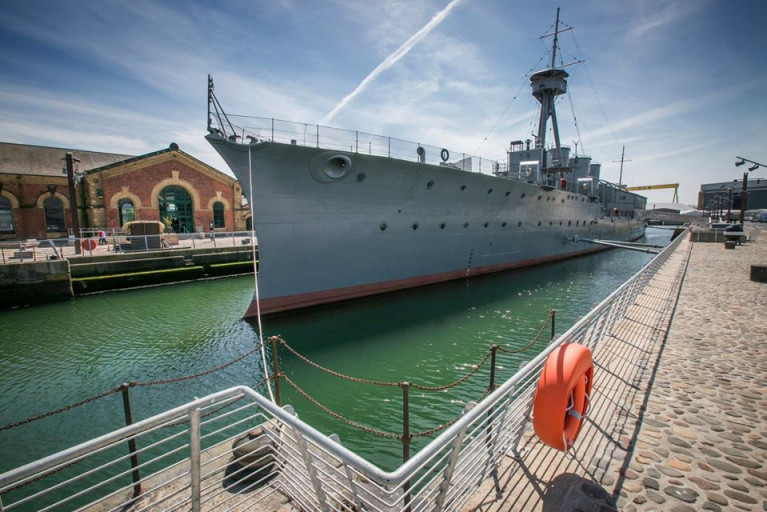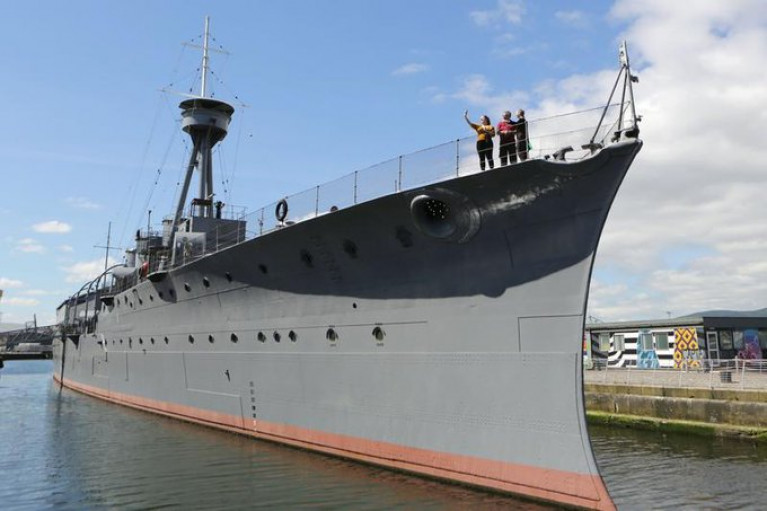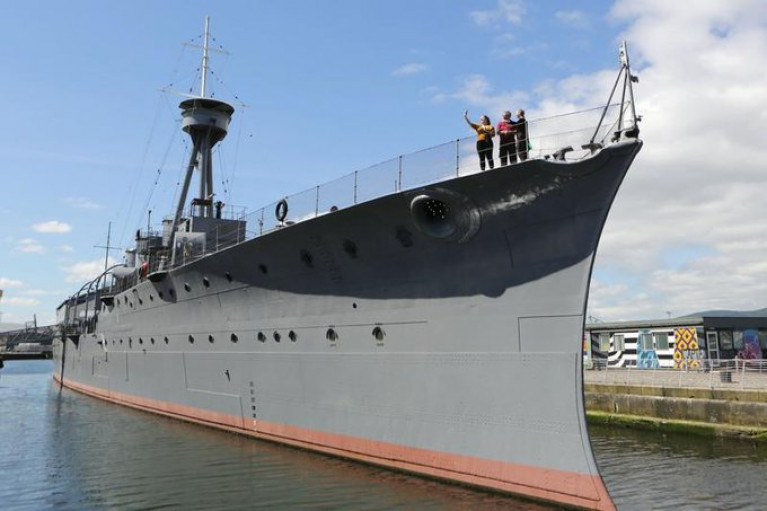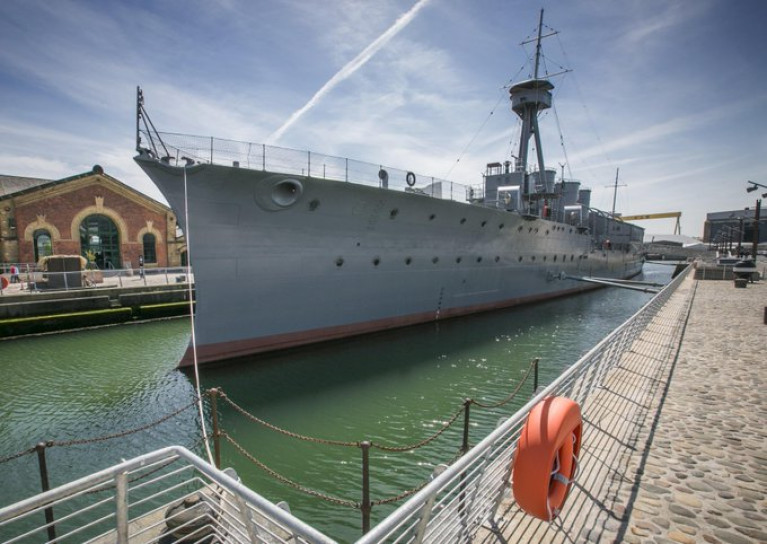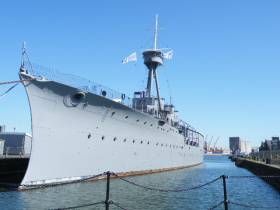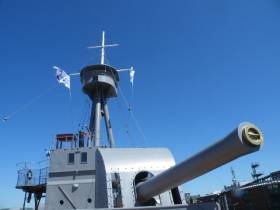Displaying items by tag: HMS Caroline
National Historic Ships UK 2023 Winners Featuring Belfast’s Awarded Flagship HMS Caroline
Winners of the National Historic Ships UK 2023 Photography Competition, Marsh Volunteer Awards, and Excellence in Maritime Conservation Award were revealed on Wednesday 22 November, during an Awards Ceremony filmed at The Royal Yacht Britannia in Leith Docks, Edinburgh and streamed online.
The Awards film also celebrated the six Flagships of the Year, among them the Belfast Harbour based HMS Caroline, as Afloat reported of the National Historic Ships announced earlier in the season. In addition to featuring some exclusive content filmed aboard Britannia, including an exclusive interview on the Royal Racing Yacht Bloodhound.
To watch the Awards film on YouTube, click here
National Historic Ships UK’s (NHS-UK) annual awards are a celebration of maritime heritage around the UK. They encourage people of all ages and backgrounds to engage with historic vessels through photography, volunteering, conservation, online activities, and skills-based training.
Britannia was chosen as this year’s host venue as she celebrates two special anniversaries in 2023 - 70 years since her launch, and 25 years as a visitor attraction. Guest presenters were Norfolk sailor and boat restorer Ash Faire-Ring, and historian and TV presenter Dan Snow.
Flagships of the Year
The annual Flagship of the Year Awards provide an opportunity to demonstrate and celebrate the value of historic vessels to the wider public, through online activities, museum engagement, events, open days and special tours.
Flagships promote the role of NHS-UK and ‘fly the flag’ as ambassadors for the UK’s maritime heritage sector. This year, the judges were especially impressed by the high quality of applications, and therefore awarded Flagship status to a record three Operational and three Static vessels.
Operational Flagships of the Year 2023
Swan (Lerwick, Shetland)
Lady of the Lake (Ullswater, Cumbria)
The Chieftain (Whitstable, Kent)
Static Flagships of the Year 2023
HMS Caroline (Belfast)
LV21 (Gravesend, Kent)
Marjorie R (Leeds, West Yorkshire)
Meet our 2023 Flagships, by clicking here and specifically for HMS Belfast, this link.
For more links regarding the Photography Competition, Marsh Volunteer Awards, and Excellence in Maritime Conservation Award, click here.
National Historic Ships UK Announce Its 'Flagships of the Year' for 2023 Among them HMS Caroline
National Historic Ships UK, the official voice for historic vessels has today appointed six vessels from around the UK to act as its 'Flagships of the Year' for 2023 and ‘fly the flag’ for maritime heritage.
The 2023 Flagships of the Year are:
HMS Caroline - the last remaining survivor of the WWI Battle of Jutland, now a museum ship in Belfast operated by the National Museum of the Royal Navy
The veteran vessel which Afloat highlight is this year 109 years old, received the award ‘in recognition of her planned public engagement into 2024 as well as the level of social media output and learning resources for schools.’
Swan - former Shetland fishing vessel converted to a sail training ship welcoming all ages and abilities
Lady of the Lake - Victorian Lake District ‘steamer’ believed to be the oldest working passenger vessel in the world
The Chieftain - former Barmouth lifeboat which saved 132 lives and now offers public boat trips from Whitstable Harbour
LV21 - 40 metre steel-hulled lightship which now operates as an art, culture and performance space moored on the River Thames at Gravesend
Marjorie R - former West Yorkshire coal barge converted into a floating independent bookshop in Leeds Dock
The 2023 Flagships will receive a special broad pennant to fly at the masthead and a brass plaque.
Each Flagship will be holding a flag-hoisting ceremony during June and July 2023 to celebrate its new status.
NHS-UK’s annual Flagship Awards have been running since 2009. The Awards provide an opportunity to demonstrate and celebrate the value of historic vessels to the wider public. This can be through a variety of online activities, special events, open days, workshops and tours. Competition was particularly strong for the coveted accolade this year.
Applications were received from a range of operational and static vessels on the National Registers based on their seasonal programmes and planned level of outreach. NHS-UK has awarded six very different craft the status of Flagship of the Year 2023; three operational and three static vessels.
Flagships promote the role of National Historic Ships UK by publicising its annual Photo Competition, Excellence in Maritime Conservation and Marsh Volunteer Awards. They will also be flying the flag as ambassadors for the UK’s maritime heritage sector. NHS-UK will work closely with each of the Flagships to promote their vessel and offer support and advice.
Operational Flagships of the Year 2023
Swan, ‘Fifie’, built 1900 (Lerwick, Shetland) see website
Awarded in recognition of her participation in the Tall Ships Race which will be hosted in Shetland this year, the projected visitor numbers resulting from this and the strength of her links with local groups and communities.
Launched from Lerwick in 1900, Swan fished under sail until 1935, by which time she was one of only five sailing herring drifters left in Shetland. Fitted with an engine, she continued to fish until the 1950s, and left Shetland in 1960 for conversion to a houseboat. Following several owners, she was rediscovered in Hartlepool submerged and neglected. The Swan Trust was formed in 1990 to save her. After a major restoration, Swan was re-launched in 1996. Based in Shetland, Swan now operates as a sail training and charter vessel and is a regular entrant in the Tall Ships Races. Each year she takes out hundreds of students from schools and youth groups, as well as members of community groups and the general public.
Lady of the Lake, passenger vessel, built 1877 (Ullswater, Cumbria) see website.
Awarded in recognition of her planned PR and marketing campaign, local business partnerships and the high number of passengers carried in the last 12 months.
Lady of the Lake was one of the original ships of the Ullswater Steam Navigation Company, which was founded in 1859 to transport goods, mail, and passengers up and down Ullswater lake. From 1910, she was a Royal Mail Steamer carrying mail from Howton to Patterdale. She has survived two sinkings and a fire and is now a commercial pleasure steamer on Ullswater. Lady of the Lake is one of a fleet of five heritage boats owned by Ullswater Steamers. She is believed to be the oldest working passenger vessel in the world.
The Chieftain, lifeboat, built 1948 (Whitstable, Kent) see website.
Awarded in recognition of the day trips and open days planned as part of her 75th anniversary and her growing presence on social media.
Twin screw Liverpool class lifeboat which served as the Barmouth lifeboat from 1949 to 1982 and saved 132 lives. Restored to her former glory in the 2000s, The Chieftain now operates boat trips and seal safaris from Whitstable harbour in Kent. She retains 90% of her original timber and all her original fittings.
Static Flagships of the Year 2023
HMS Caroline, Naval cruiser, built 1914 (Belfast, Northern Ireland) click here for website.
Awarded in recognition of her planned public engagement into 2024 (which marks the centenary of her being berthed in Belfast), as well as the level of social media output and learning resources for schools.
HMS Caroline was one of a class of six light cruisers built by Cammell Laird, Birkenhead on Merseyside in time for the outbreak of the Great War. Launched and commissioned in 1914, she joined the Grand Fleet at Scapa Flow. In 1916 she was engaged in the Battle of Jutland. In the 1990s she became the Reserve Training Centre to recruit and train Royal Navy Reserve officers and ratings.
Operated by the National Museum of the Royal Navy, HMS Caroline is now a hugely popular visitor attraction and museum in Belfast, where she has been berthed for 99 years. The ship re-opened at Easter 2023 after a three-year closure due to the pandemic, with several newly refurbished galleries. HMS Caroline is the last surviving vessel of any nation which fought at the Battle of Jutland.
LV21, light vessel, built 1963 (Gravesend, Kent) see website.
Awarded in recognition of a year of planned celebratory activities to commemorate the 60th anniversary of her launch, including public open days and a creative new learning package.
Built in 1963 Light Vessel 21 is a unique 40 metre steel-hulled lightship, the last of the renowned Philip & Son’s ships to be commissioned by Trinity House. LV21 saw most of her service off the Kent coast on the Varne, East Goodwin and Channel stations.
In 1981 she was involved in the worst light vessel collision in which the light vessel survived. Retired from service in 2008, LV21 now operates as a maritime heritage facility, art, culture and performance space. Moored next to Gravesend Pier on the River Thames, she celebrates her 60th birthday this year.
Marjorie R, coal barge, built 1946 (Leeds, West Yorkshire) see website.
Awarded in recognition of her unique offer as an independent bookshop and community base, as well as a planned art programme, exhibition and developing local relationships.
Marjorie R was a working West Yorkshire Coal Barge for many years. After her retirement she spent brief periods being lived on, neglected, sunk and re-floated twice before being burnt out and left to rust. Her current owners bought her as a project in 2012 and converted her to a houseboat. After six years of living on the vessel, they decided to redevelop it into a floating independent bookshop. The Hold Fast Bookshop opened in November 2022 and is moored in Leeds Dock.
The Awards
The NHS-UK annual Awards have run since 2010 and celebrate historic vessels at their best.
The ceremony reveals the winners of the annual Photography Competition, Excellence in Maritime Conservation and Marsh Volunteer Awards, as well as the Flagships of the Year.
The event was first hosted virtually during the pandemic and has remained online since to reach as wide an audience as possible.
Filmed at a top UK maritime location each year, the Awards hosted by Britannia, will include content created by the winners, plus tours and scenes from the host venue. The resulting film will be streamed from the NHS-UK website on Tuesday, 21 November 2023.
About National Historic Ships UK
NHS-UK is a government funded, independent organisation which gives objective advice to UK governments and local authorities, funding bodies, and the historic ships sector on all matters relating to historic vessels in the UK.
It maintains the National Register of Historic Vessels, which lists over 1,500 historic craft. It also manages the Shipshape Network, which was set up to promote the regeneration of traditional maritime skills around the UK.
For more information visit www.nationalhistoricships.org.uk
Reopening of HMS Caroline to take Place After Almost Three Year Closure
Among Belfast’s leading visitor attractions is HMS Caroline which is set to reopen in the city’s harbour after almost three years of closure.
The WWI C-class light-cruiser HMS Caroline, which is the only surviving ship from that war’s Battle of Jutland off Denmark, is to reopen daily from 1st April.
In addition HMS Caroline which was built in Birkenhead, England, is to have opening times at the weekend throughout March.
The ship built in 1914 is located in Thompson Dry-Dock, has been painstakingly restored and offers visitors the opportunity to experience life aboard the veteran vessel.
HMS Caroline is largely intact from the day it was completed at the Cammell Laird shipbuilder more than a century ago, including its living quarters, signal school, engine room, sick bay and galley.
Visitors to the museum ship will be able to journey back to a dangerous life at sea during WW1. Exhibits and displays on board allow visitors to learn to crack codes, launch torpedoes and signal ships through interactive displays.
Access to where the crew and slept is available to explore and also to hear their stories and find out about the incredible mascots that lived alongside them.
More from The Irish News on the 4,000 tonnes museum ship.
Veteran of WW1 HMS Caroline Is to Remain in Belfast Harbour
HMS Caroline, the last remaining historic naval ship from one of the First World War's most famous sea battles (Jutland), is to remain in Belfast Harbour.
As ITV News reports, HMS Caroline has been in the city since 1924 and reopened as a tourist attraction seven years ago.
Economy Minister Gordon Lyons MLA says the long-term future of the ship has been secured with it staying in Belfast until at least 2038.
There had been fears that the ship could have been towed to Portsmouth after being closed for much of the Covid-19 pandemic.
However, agreement has been reached between the Department for the Economy, the National Museum of the Royal Navy (NMRN) and The National Lottery Heritage Fund.
The ship is earmarked to reopen at the end of the summer.
More on the veteran vessel here.
WWI Veteran HMS Caroline Museum Granted Reprieve
Belfast Harbour based HMS Caroline museum has won a reprieve following months of uncertainty over its future.
The Battle of Jutland veteran vessel turned tourist attraction faced a major loss of income after closing during lockdown.
The National Museum of the Royal Navy (NMRN) closed Caroline and other visitor facilities in Portsmouth, Gosport, Hartlepool and Yeovilton at the outbreak of the coronavirus pandemic.
It says the loss of ticketing revenue during lockdown has left it with a £6.35 million budget shortfall.
While the Treasury has offered the museum an emergency grant to reopen its sites in England, in Northern Ireland its funding arrangement is with the devolved executive.
On Friday the NMRN confirmed that it has now come to a joint understanding with Stormont’s Department for Economy.
For further reading Belfast Telegraph reports
A World War One naval heritage vessel HMS Caroline - the only surviving ship from the Battle of Jutland and one of Belfast’s leading visitor attractions - will remain closed until 2021 due to funding pressures.
The National Museum of the Royal Navy (NMRN), which operates HMS Caroline in the Titanic Quarter on behalf of the Northern Ireland executive, said the decision was taken after an operations and funding agreement could not be reached with the Department for the Economy (DfE).
HMS Caroline had been temporarily closed since March 17 in line with public health advice.
The operational agreement for HMS Caroline expired on 30 June, leaving NMRN unable to go on operating the ship.
For further reading reports the Belfast Telegraph here.
Historic WW1 vessel HMS Caroline based in Belfast Harbour has been placed in a “dire” situation” by the coronavirus crisis and the resulting loss of revenue, the National Museum of the Royal Navy (NMRN) has warned.
Due to the countrywide shutdown, writes the Newsletter, the 1916 Battle of Jutland survivor will mark its fourth anniversary since a £15 million refurbishment closed it to much-needed visitors.
While many of the UK’s national museums receive up to 80% funding from central government, the attractions operated by the NMRN are allocated only 19% with the remainder self-generated.
Dominic Tweddle, the NMRN’s general director, said: “Currently 91% of the staff at HMS Caroline have been asked to take furlough leave, something that has been critical in helping us manage our financial position.
More here on the WW1 light battle-cruiser which Afloat adds last year was shortlisted for the 2019 Art Fund Museum of the Year award.
Exhibition of Art-Works Sets Sail on HMS Caroline
On board HMS Caroline an exhibition of artworks produced by a community group in Belfast forms part of a National Heritage Lottery Fund project.
As the Belfast Telegraph writes, Members of Forthspring Inter-Community Centre have used their artistic talents to produce a series of paintings, sculptures and textiles to produce the Art Trail exhibition, art pieces inspired by the World War One ship which is moored in Belfast Harbour.
Ruth Osborne, learning and community engagement manager at HMS Caroline, said the project shines a light on archival material including photographic collections and sailors' diaries which were saved with the ship.
The pieces themselves have been installed in various locations on board. HMS Caroline has been engaging with communities across Northern Ireland since 2016.
A World War 1 veteran HMS Caroline has according to the BelfastTelegraph, been tipped as favourite to win the prestigious Art Fund Museum of the Year Award.
Bookmaker Sean Graham has given the recently restored Belfast-based ship, which saw service in the First World War, odds of 4-7 in the hotly-contested competition.
The city dock attraction joins four other high-profile venues in the running for the accolade, going up against Nottingham Contemporary, which has been given odds of 2-1, St Fagan's National Museum of History in Cardiff (4-1), V&A Dundee and the Pitt-Rivers Museum, Oxford, (both ranked at 6-1).
The winning entrant, announced at a ceremony held in the Science Museum in London this evening, will receive £100,000. The runners-up will each receive £10,000 in recognition of their achievements.
The Art Fund prize aims to champion what museums do and encourage more people to experience what makes a truly outstanding museum.
To read more click here on the last floating survivor of the 1916 Battle of Jutland.
#historicboats - A World War One warship HMS Caroline has been shortlisted for the 2019 Art Fund Museum of the Year award.
The Belfast-based vessel reports BBC News will compete against four other UK museums for the prestigious prize, worth £100,000.
HMS Caroline is the Royal Navy's sole surviving ship from the 1916 Battle of Jutland, the biggest sea battle of the conflict.
The warship opened to the public as a museum on the centenary of the battle.
Built in 1914 in Birkenhead in England, HMS Caroline was one of the fastest warships of its time.
The Battle of Jutland - off the coast of Denmark - involved some 250 ships from the Royal Navy's Grand Fleet and the German High Seas Fleet.
More than 8,500 sailors lost their lives in the 12-hour battle on 31 May and 1 June 1916.
After the war, HMS Caroline was berthed in Belfast as a training ship, but also saw service in World War Two.
More on this story can be read here.




























